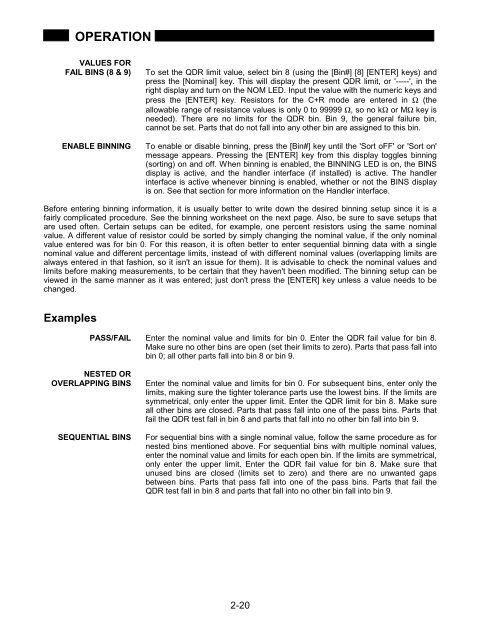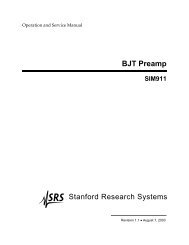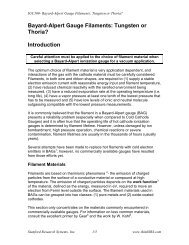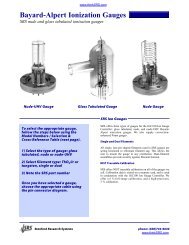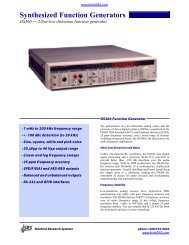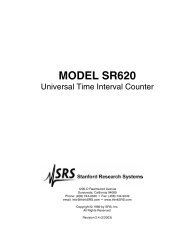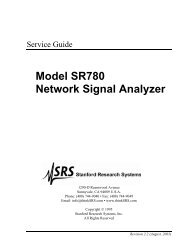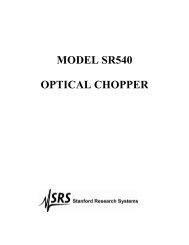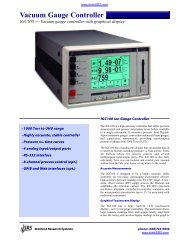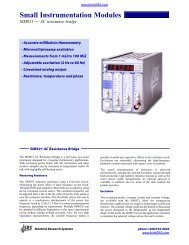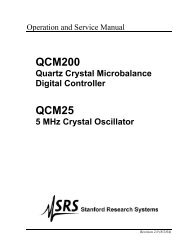Model SR715 Model SR720 LCR Meters
Model SR715 Model SR720 LCR Meters
Model SR715 Model SR720 LCR Meters
- No tags were found...
You also want an ePaper? Increase the reach of your titles
YUMPU automatically turns print PDFs into web optimized ePapers that Google loves.
OPERATIONVALUES FORFAIL BINS (8 & 9)ENABLE BINNINGTo set the QDR limit value, select bin 8 (using the [Bin#] [8] [ENTER] keys) andpress the [Nominal] key. This will display the present QDR limit, or '-----', in theright display and turn on the NOM LED. Input the value with the numeric keys andpress the [ENTER] key. Resistors for the C+R mode are entered in Ω (theallowable range of resistance values is only 0 to 99999 Ω, so no kΩ or MΩ key isneeded). There are no limits for the QDR bin. Bin 9, the general failure bin,cannot be set. Parts that do not fall into any other bin are assigned to this bin.To enable or disable binning, press the [Bin#] key until the 'Sort oFF' or 'Sort on'message appears. Pressing the [ENTER] key from this display toggles binning(sorting) on and off. When binning is enabled, the BINNING LED is on, the BINSdisplay is active, and the handler interface (if installed) is active. The handlerinterface is active whenever binning is enabled, whether or not the BINS displayis on. See that section for more information on the Handler interface.Before entering binning information, it is usually better to write down the desired binning setup since it is afairly complicated procedure. See the binning worksheet on the next page. Also, be sure to save setups thatare used often. Certain setups can be edited, for example, one percent resistors using the same nominalvalue. A different value of resistor could be sorted by simply changing the nominal value, if the only nominalvalue entered was for bin 0. For this reason, it is often better to enter sequential binning data with a singlenominal value and different percentage limits, instead of with different nominal values (overlapping limits arealways entered in that fashion, so it isn't an issue for them). It is advisable to check the nominal values andlimits before making measurements, to be certain that they haven't been modified. The binning setup can beviewed in the same manner as it was entered; just don't press the [ENTER] key unless a value needs to bechanged.ExamplesPASS/FAIL Enter the nominal value and limits for bin 0. Enter the QDR fail value for bin 8.Make sure no other bins are open (set their limits to zero). Parts that pass fall intobin 0; all other parts fall into bin 8 or bin 9.NESTED OROVERLAPPING BINSSEQUENTIAL BINSEnter the nominal value and limits for bin 0. For subsequent bins, enter only thelimits, making sure the tighter tolerance parts use the lowest bins. If the limits aresymmetrical, only enter the upper limit. Enter the QDR limit for bin 8. Make sureall other bins are closed. Parts that pass fall into one of the pass bins. Parts thatfail the QDR test fall in bin 8 and parts that fall into no other bin fall into bin 9.For sequential bins with a single nominal value, follow the same procedure as fornested bins mentioned above. For sequential bins with multiple nominal values,enter the nominal value and limits for each open bin. If the limits are symmetrical,only enter the upper limit. Enter the QDR fail value for bin 8. Make sure thatunused bins are closed (limits set to zero) and there are no unwanted gapsbetween bins. Parts that pass fall into one of the pass bins. Parts that fail theQDR test fall in bin 8 and parts that fall into no other bin fall into bin 9.2-20


